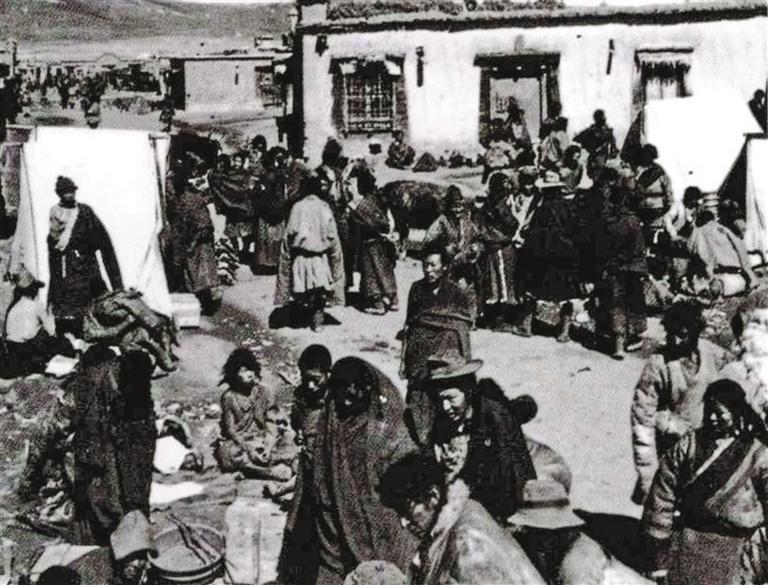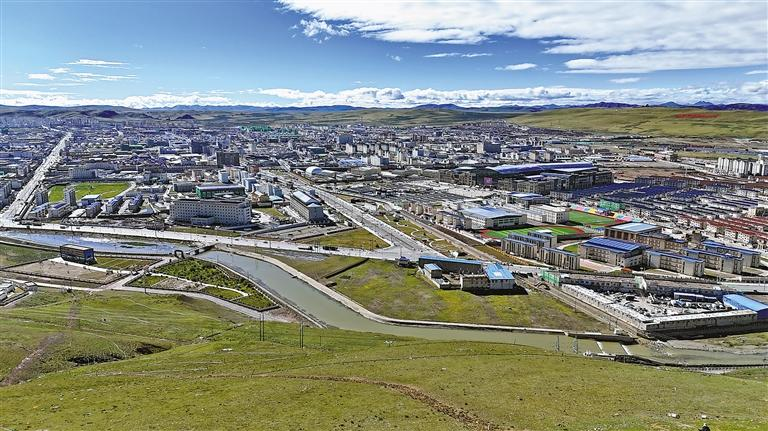Source:xzxw.com 2025-08-19

Nagqu Town before Xizang's Democratic Reform (archival photo)

Viewing Nagqu Town from afar atop Mount Tacha
Rivers, woodlands, lakes, boats, parks, memorial corridorsand archways, temples, white pagodas, pavilions, grasslands... These diverse urban landscapes, when woven together, form the key town of Nagquin northern Xizang, which sits at an average elevation of 4,500 meters.
The Seni River, a small grassland river that runs east to west through the city, flows quietly, serving as a vibrant waterway and a continuous cultural vein that nourishes the city. In 2017, Nagqu County was redesignated as a district and named "Seni," which derived from this very river.
Historically, Nagqu was a crucial city on the Ancient Tea Horse Road, with important officials passing through on their journey between Xizang and other parts of the country throughout the ages. Besides local herders, merchants from Xining, Yushu, Lhasa, Shannan, Ngari, Qamdo, and other places also gathered here.
Nagqu Town was built along the river and thrived through trade. As a significant town on the Ancient Tea Horse Road, it has grown increasingly prosperous with the successive opening of the Qinghai-Xizang Highway, National Highway 317, and the Qinghai-Xizang Railway. Today, modern commercial establishments such as high-end hotels, chain restaurants, large supermarkets, and farmers' markets are scattered throughout its streets and alleys, transforming the former "big village" into a vibrant new grassland city.
Strolling westward along the Seni River, thegreen belt stretches on, dotted withmorethan a dozen of red willows, while flocks of sparrows flit among them, creating a lively scene.
This is the Heihe Street Lingkor Community, home to the Ethnic Unity Park and Square, and the heart of the old town. With the completion of parks, squares, green spaces, and detached courtyard housing complexes, the once old, shabby, and dirty living environment has become a thing of the past. No one feels this transformation more deeply than the "old Nagqu residents" of the Heihe Street Lingkor Community.
As introduced by old man Gephel, before the Democratic Reform, this area was known as "Seru," meaning "gray old tents." Because in the past, impoverished herders lived in faded old tents that appeared grayish-white. Later, as the people's lives improved, they began wearing brightly colored clothes. After the establishment of the Xizang Autonomous Region, the people largely bid farewell to tents and moved into adobe houses. After the 18th National Congress of the Communist Party of China, the government implemented shantytown renovations, and everyone moved into Tibetan-style courtyard houses. Now, it is called Lingkor Community Unity Neighborhood.
At the Tacha Mountain Scenic Area, the Seni River converges with the Tsequ River, which flows from the north. Crossing a bridge, one finds the High-Altitude Tree Planting Base and the Sanjiangyuan National Park Science Popularization, Education, and Monitoring Center.
Following a winding path uphill, the outline of Nagqu Town gradually comes into view, unfolding like a scroll beneath the feet. Pausing to look back, high-rise buildings stand in rows, and long streets bustle with traffic. Reflecting on the past "big village" composed of earthen houses and tents, and gazing at the dazzling lights of the grassland city today, how can one not feel excited at the remarkable development that has taken place?
Today in Nagqu, people live in peace and contentment, their happy smiles blooming like the flowers. The future of Nagqu, thepearl of northern Xizang, is destined to shine even more brilliantly.
Reporters: Zhao Shubin, Wan Jing, Wang Chun
Translator: Peng Qing, Liu Fang
Review: Purbu Tsering, Dong Xiuli
Copyright © Xizang Daily & China Xizang News All rights reserved
Reproduction in whole or in part without permissions prohibited
Index Code: 藏 ICP 备 05000021 号
Producer: Xizang Daily International Communication Center